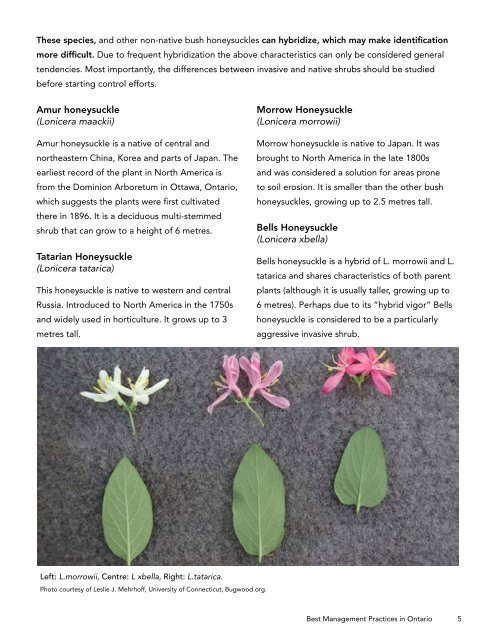OIPC_BMP_Honeysuckle_Feb182014_FINAL2
OIPC_BMP_Honeysuckle_Feb182014_FINAL2
OIPC_BMP_Honeysuckle_Feb182014_FINAL2
You also want an ePaper? Increase the reach of your titles
YUMPU automatically turns print PDFs into web optimized ePapers that Google loves.
These species, and other non-native bush honeysuckles can hybridize, which may make identification<br />
more difficult. Due to frequent hybridization the above characteristics can only be considered general<br />
tendencies. Most importantly, the differences between invasive and native shrubs should be studied<br />
before starting control efforts.<br />
Amur honeysuckle<br />
(Lonicera maackii)<br />
Amur honeysuckle is a native of central and<br />
northeastern China, Korea and parts of Japan. The<br />
earliest record of the plant in North America is<br />
from the Dominion Arboretum in Ottawa, Ontario,<br />
which suggests the plants were first cultivated<br />
there in 1896. It is a deciduous multi-stemmed<br />
shrub that can grow to a height of 6 metres.<br />
Tatarian <strong>Honeysuckle</strong><br />
(Lonicera tatarica)<br />
This honeysuckle is native to western and central<br />
Russia. Introduced to North America in the 1750s<br />
and widely used in horticulture. It grows up to 3<br />
metres tall.<br />
Morrow <strong>Honeysuckle</strong><br />
(Lonicera morrowii)<br />
Morrow honeysuckle is native to Japan. It was<br />
brought to North America in the late 1800s<br />
and was considered a solution for areas prone<br />
to soil erosion. It is smaller than the other bush<br />
honeysuckles, growing up to 2.5 metres tall.<br />
Bells <strong>Honeysuckle</strong><br />
(Lonicera xbella)<br />
Bells honeysuckle is a hybrid of L. morrowii and L.<br />
tatarica and shares characteristics of both parent<br />
plants (although it is usually taller, growing up to<br />
6 metres). Perhaps due to its “hybrid vigor” Bells<br />
honeysuckle is considered to be a particularly<br />
aggressive invasive shrub.<br />
Left: L.morrowii, Centre: L xbella, Right: L.tatarica.<br />
Photo courtesy of Leslie J. Mehrhoff, University of Connecticut, Bugwood.org.<br />
Best Management Practices in Ontario<br />
5



